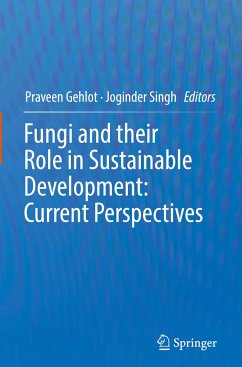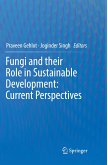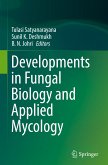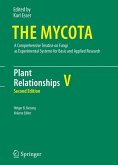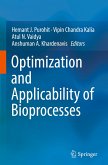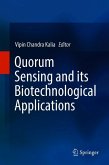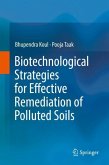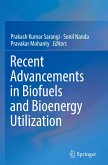Fungi and their Role in Sustainable Development: Current Perspectives
Herausgegeben:Gehlot, Praveen; Singh, Joginder
Fungi and their Role in Sustainable Development: Current Perspectives
Herausgegeben:Gehlot, Praveen; Singh, Joginder
- Gebundenes Buch
- Merkliste
- Auf die Merkliste
- Bewerten Bewerten
- Teilen
- Produkt teilen
- Produkterinnerung
- Produkterinnerung
This book illustrates the multiple roles of fungi in everyday life. Fungi are the large group of organisms with tremendous diversity and economic importance. Their ability to produce commercially efficient useful products makes them the vulnerable sustainable tool for the future generation. This book describes a systems approach and provides a means to share the latest developments and advances about the benefits of fungi including their wide application, traditional uses, modern practices, along with designing of strategies to harness their potential. The chapters are organized with data,…mehr
Andere Kunden interessierten sich auch für
![Fungi and their Role in Sustainable Development: Current Perspectives Fungi and their Role in Sustainable Development: Current Perspectives]() Fungi and their Role in Sustainable Development: Current Perspectives155,99 €
Fungi and their Role in Sustainable Development: Current Perspectives155,99 €![Developments in Fungal Biology and Applied Mycology Developments in Fungal Biology and Applied Mycology]() Developments in Fungal Biology and Applied Mycology232,99 €
Developments in Fungal Biology and Applied Mycology232,99 €![Plant Relationships Plant Relationships]() Holger B. Deising (Volume editor)Plant Relationships155,99 €
Holger B. Deising (Volume editor)Plant Relationships155,99 €![Optimization and Applicability of Bioprocesses Optimization and Applicability of Bioprocesses]() Optimization and Applicability of Bioprocesses116,99 €
Optimization and Applicability of Bioprocesses116,99 €![Quorum Sensing and its Biotechnological Applications Quorum Sensing and its Biotechnological Applications]() Quorum Sensing and its Biotechnological Applications77,99 €
Quorum Sensing and its Biotechnological Applications77,99 €![Biotechnological Strategies for Effective Remediation of Polluted Soils Biotechnological Strategies for Effective Remediation of Polluted Soils]() Bhupendra KoulBiotechnological Strategies for Effective Remediation of Polluted Soils116,99 €
Bhupendra KoulBiotechnological Strategies for Effective Remediation of Polluted Soils116,99 €![Recent Advancements in Biofuels and Bioenergy Utilization Recent Advancements in Biofuels and Bioenergy Utilization]() Recent Advancements in Biofuels and Bioenergy Utilization77,99 €
Recent Advancements in Biofuels and Bioenergy Utilization77,99 €-
-
-
This book illustrates the multiple roles of fungi in everyday life. Fungi are the large group of organisms with tremendous diversity and economic importance. Their ability to produce commercially efficient useful products makes them the vulnerable sustainable tool for the future generation. This book describes a systems approach and provides a means to share the latest developments and advances about the benefits of fungi including their wide application, traditional uses, modern practices, along with designing of strategies to harness their potential. The chapters are organized with data, providing information related to different sustainable aspects of fungi in agriculture, its cultivation and conservation strategies, industrial and environmental utilization, advanced bioconversion technologies and modern biotechnological interventions. Updated information and current opinion related to its application for sustainable agriculture, environment, and industries as futuristic toolshavebeen presented and discussed in different chapters. The book also elucidates a comprehensive yet a representative description of the challenges associated with the sustained application of fungi to achieve the goals of sustainability.
Produktdetails
- Produktdetails
- Verlag: Springer / Springer Nature Singapore / Springer, Berlin
- Artikelnr. des Verlages: 978-981-13-0392-0
- 1st edition 2018
- Seitenzahl: 792
- Erscheinungstermin: 25. September 2018
- Englisch
- Abmessung: 241mm x 160mm x 45mm
- Gewicht: 1406g
- ISBN-13: 9789811303920
- ISBN-10: 9811303924
- Artikelnr.: 52337709
- Herstellerkennzeichnung Die Herstellerinformationen sind derzeit nicht verfügbar.
- Verlag: Springer / Springer Nature Singapore / Springer, Berlin
- Artikelnr. des Verlages: 978-981-13-0392-0
- 1st edition 2018
- Seitenzahl: 792
- Erscheinungstermin: 25. September 2018
- Englisch
- Abmessung: 241mm x 160mm x 45mm
- Gewicht: 1406g
- ISBN-13: 9789811303920
- ISBN-10: 9811303924
- Artikelnr.: 52337709
- Herstellerkennzeichnung Die Herstellerinformationen sind derzeit nicht verfügbar.
¿Dr. Praveen Gehlot is Associate Professor, Department of Botany, Jai Narain Vyas University, Jodhpur, India. He did his Ph.D. from JNV University Jodhpur, under the able guidance of Prof. D.K. Purohit. He has about 18 years of teaching and research experience. He has been an awardee of Young Scientist under FAST Track Scheme by Department of Science and Technology, New Delhi and later worked as a Pool-Officer of Council of Scientific and Industrial Research, New Delhi. Earlier, he taught at Budha Institute of Technology and Science Research College, Jodhpur and Government Bangor PG College, Pali, Rajasthan and subsequently served as an Associate Professor and Head, Department of Microbiology, Maharaja Ganga Singh University, Bikaner, Rajasthan. Dr. Gehlot has successfully completed three major research projects sponsored by UGC, DST and CSIR. He has published more than 75 research papers, book chapters and review articles in journals of international and national reputeand has edited three books entitled "Pyrenomycetes Fungi", "Arbuscular Mycorrhizal Fungi" and "Microbes: In Action" published by AgroBios, India. He attended several International and National Seminars, Symposia, Conferences and chaired technical sessions. He is an active member of various scientific societies, including Mycological Society of India, Society of Mycology and Plant Pathology, India, Association of Microbiologists of India, Indian Science Congress Association. Dr. Joginder Singh Panwar is presently working as an Associate Professor at the Department of Biotechnology, Lovely Professional University, Punjab, India. Previously, he has worked as Young Scientist at Microbial Biotechnology and Biofertilizer Laboratory, Department of Botany, Jai Narain Vyas University in Department of Science and Technology, Govt. of India. His research interest is to explore different efficient strategies towards bioremediation and phytoremediation of pollutants from water and soil. Presently, he is working on designing and development of cleanup technology (biofilters) for in-situ bioremediation of textile industrial effluents. He is an active member of various scientific societies and organizations including, Association of Microbiologists of India, Indian Society of Salinity Research Scientists, Indian Society for Radiation Biology, and European Federation of Biotechnology. Till now, he has published more than 60 research and review articles in the peer-reviewed journals and authored or co-authored numerous books and book chapters.
Part 1. Sustainable Cultivation and Conservation Strategies of Fungi.- Chapter 1. Cultivation, conservation and medicinal significance of macro-fungi.- Chapter 2. Fungi as biocontrol agent: an alternate to chemicals.- Chapter 3. Incredible Role of Fungi in various Fields for sustainable development.- Chapter 4. The biological promises of endophytic Muscodor species.- Chapter 5. Slime Moulds: The Tiny Charmers.- Chapter 6. Fungal Biotechnology: Role and Aspects.- Part 2. Sustainable Aspects of Fungi in Agriculture.- Chapter 7. Fungal Endophytes: Role in Sustainable Agriculture.- Chapter 8. Fungal endophytes and their secondary metabolites - Role in sustainable agriculture.- Chapter 9. Agricultural important microorganism- Sustainability from rhizosphere to bioformulation as weapon for biological control.- Chapter 10. Recruit the Plant Pathogen for Weed Management: Bioherbicide - A Sustainable Strategy.- Chapter 11. Mycopesticides: Fungal based pesticides for sustainable agriculture.- Chapter 12. Multifactorial role of Arbuscular Mycorrhizae in Agroecosystem.- Chapter 13. Strategic approaches for applications of entomopathogenic fungi to counter insecticide resistance in agriculturally important insect pests.- Chapter 14. Arbuscular Mycorrhizal Fungi as phosphate fertilizer for crop plants and their role in bioremediation of heavy metals.- Chapter 15. Fungal community in mitigating impacts of drought in plants.- Chapter 16. Role of Fungi as Biocontrol Agents for the Control of Plant Diseases in Sustainable Agriculture.- Chapter 17. Fungal disease management in chickpea: current status and future prospects.- Chapter 18. Recent approaches for late blight disease management of potato caused by Phytophthora infestans.- Part 3. Fungi for sustainable Industrial and Environmental Aspects.- Chapter 19. Recent advances and industrial applications of microbial xylanases: A review.- Chapter 20. Bio-Valorization of Dairy Whey for Bio-Ethanol by Stress Tolerance Yeast.- Chapter 21. Nutritional quality attributes of edible gasteroid wild mushroom Astraeus hygrometricus.- Chapter 22. Biotechnology of Fungal Lipases.- Chapter 23. Biopigments: Fungal Pigments.- Chapter 24. Bioethanol Production from Renewable Biomass by Yeast.- Chapter 25. Fungi Inhabiting in Hypersaline Conditions - An Insight.- Chapter 26. Carbon sequestration and the significance of soil fungi in the process.- Chapter 27. Fungal infections and Intervention in Diabetic complication.- Part 4. Bioconversion Technologies of Fungi.- Chapter 28. Arbuscular Mycorrhizal Fungi: Effects on secondary metabolite production in medicinal plants.- Chapter 29. Endophytic fungi: Carrier of potential antioxidants.- Chapter 30. Current perspectives of Endophytic fungi in Sustainable Development.- Chapter 31. Marine Fungi for Sustainable Development.- Chapter 32. Fungi-mediated biodeterioration of household materials, libraries, cultural heritage and its sustainable conservation.- Chapter 33. Co-cultivation strategies to induce de-novo synthesis of novel chemical scaffolds from cryptic secondary metabolite gene clusters.- Part 5. Modern Biotechnological Interventions on Fungi.- Chapter 34. Computational approaches to understand the genome and protein sequences of fungi.- Chapter 35. Bioprospecting ofendophytic fungi for bioactive compounds.- Chapter 36. Bioactive Compounds from Endophytic Fungi.- Chapter 37. Bioactive potential of non-conventional edible wild mushroom Amanita.- Chapter 38. Fungus Monascus -fermented red yeast rice (RYR): Natural therapeutic statin source or mycotoxin?.- Chapter 39. Nanoparticles from Fungi (Myconanoparticles).
Part 1. Sustainable Cultivation and Conservation Strategies of Fungi.- Chapter 1. Cultivation, conservation and medicinal significance of macro-fungi.- Chapter 2. Fungi as biocontrol agent: an alternate to chemicals.- Chapter 3. Incredible Role of Fungi in various Fields for sustainable development.- Chapter 4. The biological promises of endophytic Muscodor species.- Chapter 5. Slime Moulds: The Tiny Charmers.- Chapter 6. Fungal Biotechnology: Role and Aspects.- Part 2. Sustainable Aspects of Fungi in Agriculture.- Chapter 7. Fungal Endophytes: Role in Sustainable Agriculture.- Chapter 8. Fungal endophytes and their secondary metabolites - Role in sustainable agriculture.- Chapter 9. Agricultural important microorganism- Sustainability from rhizosphere to bioformulation as weapon for biological control.- Chapter 10. Recruit the Plant Pathogen for Weed Management: Bioherbicide - A Sustainable Strategy.- Chapter 11. Mycopesticides: Fungal based pesticides for sustainable agriculture.- Chapter 12. Multifactorial role of Arbuscular Mycorrhizae in Agroecosystem.- Chapter 13. Strategic approaches for applications of entomopathogenic fungi to counter insecticide resistance in agriculturally important insect pests.- Chapter 14. Arbuscular Mycorrhizal Fungi as phosphate fertilizer for crop plants and their role in bioremediation of heavy metals.- Chapter 15. Fungal community in mitigating impacts of drought in plants.- Chapter 16. Role of Fungi as Biocontrol Agents for the Control of Plant Diseases in Sustainable Agriculture.- Chapter 17. Fungal disease management in chickpea: current status and future prospects.- Chapter 18. Recent approaches for late blight disease management of potato caused by Phytophthora infestans.- Part 3. Fungi for sustainable Industrial and Environmental Aspects.- Chapter 19. Recent advances and industrial applications of microbial xylanases: A review.- Chapter 20. Bio-Valorization of Dairy Whey for Bio-Ethanol by Stress Tolerance Yeast.- Chapter 21. Nutritional quality attributes of edible gasteroid wild mushroom Astraeus hygrometricus.- Chapter 22. Biotechnology of Fungal Lipases.- Chapter 23. Biopigments: Fungal Pigments.- Chapter 24. Bioethanol Production from Renewable Biomass by Yeast.- Chapter 25. Fungi Inhabiting in Hypersaline Conditions - An Insight.- Chapter 26. Carbon sequestration and the significance of soil fungi in the process.- Chapter 27. Fungal infections and Intervention in Diabetic complication.- Part 4. Bioconversion Technologies of Fungi.- Chapter 28. Arbuscular Mycorrhizal Fungi: Effects on secondary metabolite production in medicinal plants.- Chapter 29. Endophytic fungi: Carrier of potential antioxidants.- Chapter 30. Current perspectives of Endophytic fungi in Sustainable Development.- Chapter 31. Marine Fungi for Sustainable Development.- Chapter 32. Fungi-mediated biodeterioration of household materials, libraries, cultural heritage and its sustainable conservation.- Chapter 33. Co-cultivation strategies to induce de-novo synthesis of novel chemical scaffolds from cryptic secondary metabolite gene clusters.- Part 5. Modern Biotechnological Interventions on Fungi.- Chapter 34. Computational approaches to understand the genome and protein sequences of fungi.- Chapter 35. Bioprospecting ofendophytic fungi for bioactive compounds.- Chapter 36. Bioactive Compounds from Endophytic Fungi.- Chapter 37. Bioactive potential of non-conventional edible wild mushroom Amanita.- Chapter 38. Fungus Monascus -fermented red yeast rice (RYR): Natural therapeutic statin source or mycotoxin?.- Chapter 39. Nanoparticles from Fungi (Myconanoparticles).

